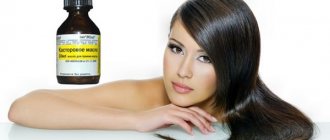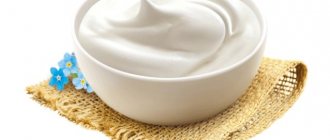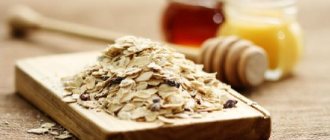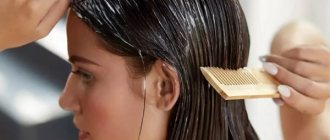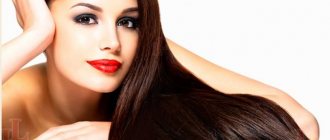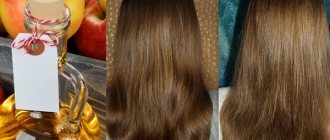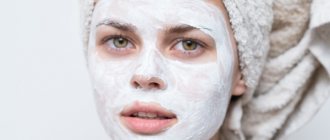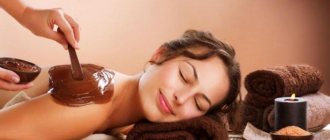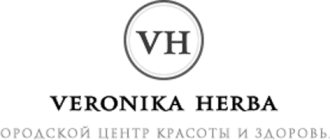Every girl dreams of thick hair that looks beautiful and well-groomed. But to achieve this, it is necessary to maintain not only their cleanliness, but also their healthy condition. To do this, you should use a variety of cosmetics, such as shampoo or conditioner. But a special effect can be achieved with the help of hair masks.
However, the result depends not only on the quality of the product, but also on proper use. Of course, manufacturers provide instructions for each product. But there are a number of nuances that remain behind the scenes. Failure to comply with them may reduce the entire beneficial effect of the procedure.
Therefore, you need to know not only how to choose a hair mask, but also how to use it.
What is a mask
A hair mask is a care cosmetic product created to moisturize, nourish and saturate the hair shafts with useful components.
An overview of all hair care methods and how to combine them correctly >>
Professional salon care >>
There is no clear classification, but based on what manufacturers offer, products can be divided according to the nature of their impact:
- moisturizing;
- nutritious;
- to add volume;
- for strengthening.
Conventionally, they are divided according to the characteristics of the hair for which they are intended:
- dry;
- damaged;
- painted;
- fat;
- normal;
- for all types;
- painted.
Moreover, one classification does not exclude the other, that is, there may be a moisturizing product for dry hair or to add volume to oily hair.
Let's talk separately about the scope of application:
- for hair;
- for the scalp.
These are completely different products that cannot replace each other. Masks for the scalp are aimed at working with the dermis and hair follicles, and for hair - with already dead cells and hair shafts. Products for the scalp are rarely used, and in general they are not so common, so further we will talk more about options for length, rather than roots.
There are also less common categories - for light, curly, lacking shine. Here everything is limited by the imagination of the manufacturer and the components that he adds to his product. And before we move on to discussing the composition, features and selection rules, important information:
The mask, like any other product, does not heal, but gives a cosmetic effect. Even the most effective product will not relieve the curls from dryness from the inside, because the visible part of the shaft is already dead tissue, which means they cannot be treated.
Main types of cosmetics by composition and effect
Masks are usually distinguished by action, type of hair and components. The first two groups include mixtures for damaged, dull, bleached or bleached hair, as well as weakened, colored, curly hair. There are separate formulations for oily, dry, normal and mixed strands.
If we talk about the main ingredients of homemade masks, the most popular are mustard, oil, gelatin, egg, beer, yeast, fruit and vegetable. Professional ones are keratin, vitamin, protein, mineral, collagen.
What does it consist of?
The ideal composition is a subjective concept, it all depends on the initial data of the curls, habits and beliefs of their owner. Yes, yes, convictions, because now attention is focused not only on the composition as such, but also on the ethics of the brand, for example. Some people do not accept products of animal origin, others are categorically against any synthetic components. In general, it is quite difficult to derive the ideal composition.
But you can understand what masks generally consist of, and what components in them are best avoided by everyone, regardless of preferences.
Most hair masks consist of:
- water is the basis;
- glycerin – retains moisture inside the hair shaft;
- cetearyl alcohol is an emulsifier. Fatty alcohol, which does not dry, but on the contrary – conditions, gives softness and shine;
- Stearamidopropyl Dimethylamine is another emulsifier that often replaces silicones in formulations, but is also found in products containing silicones. Made from rapeseed oil. It has antistatic, smoothing and conditioning properties.
- plant components - essential and fatty oils, plant extracts, proteins;
- useful additives - keratin, hyaluronic acid, vitamins, collagen, elastin;
- preservatives - can be either herbal or synthetic;
- flavorings, perfume additives.
Undesirable components include:
- ethyl alcohols . It may contain Ethyl alcohol, Ethanol, Alcohol, SD alcohol, alcohol denat. Ethyl alcohol dries, increases fragility and sensitivity;
- PEG – polyethylene glycol . An emulsifier that can cause dryness, allergies and irritation. This is not to say that it is strictly prohibited - it is often used in the food industry and natural cosmetics, but if you have a choice, it is better to refuse to buy products containing this component.
Silicones are an ambiguous component:
- on the one hand, they provide a noticeable, albeit short-term, effect of smoothness and softness of the hair, and also protect it from external influences. This means that for girls who want visible results, silicones in the composition will come in handy;
- on the other hand, they can make them heavier, provoke the formation of dandruff and make it difficult for the beneficial components of other products to penetrate.
We can definitely say that the harm of silicones in hair products is exaggerated. When choosing a product, it is important to be guided by priorities - get an immediate effect, but at the same time increase the risk of weight gain, or refuse any risks and masks with silicones. Silicones in the composition always have the ending “-cone” - dimethicones, amodimethicones, polyold dimethicones, and so on.
Effective Inexpensive Ingredients to Use at Home
Useful formulations for any hair can be easily prepared at home. Often this requires ordinary products from the refrigerator or kitchen shelf. What exactly to choose?
- Kefir is indispensable for split ends, thinning and frizzy hair. It gives volume, natural radiance, and stops hair loss. Dairy products such as sour cream, milk and yogurt take care of the health and comfort of the scalp, thickness and regeneration of weakened hair.
- Yeast reduces hair loss, retains moisture, restores elasticity, and is considered a source of B vitamins.
- Gelatin is a kind of replacement for salon lamination.
- Red pepper awakens and stimulates hair follicles.
- Cognac brightens, disinfects, dries, fights dullness, revives split ends, and protects against negative factors.
- Masks with chicken eggs reduce damage from bad weather and protect against over-drying with a hairdryer, normalize lipid balance.
- Honey reduces the risk of fragility, slow growth, thinning, and lifelessness.
- Clay masks strengthen the roots, cleanse the epidermis well, treat the ends, and fight hair loss, loss of elasticity, and seborrhea.
- Mustard warms up, increases blood flow, nutrition of the roots and, accordingly, the growth of strands.
How to choose a mask according to your hair type
Or more precisely, how to choose a mask based on your hair type or the problem that is plaguing you. The main criterion that needs to be taken into account is the composition, because it is the different components that make it possible to divide the products into nourishing, moisturizing, and strengthening.
Dry, damaged
Dry hair is characterized by fragility, split ends, and a “straw” feeling along the entire length. The roots are usually dry, often with fine dandruff.
For dry type, it is recommended to use masks with:
- fatty oils - avocado, shea butter, shea butter;
- panthenol;
- betaine;
- amino acids;
- keratin;
- hyaluronic acid;
- honey.
Products for dry hair often contain silicones - they can give an immediate effect. But there are options without silicones - “Coconut Paradise” from Organic Shop, for example.
Fat
Oily hair is characterized by greasiness at the roots, and sometimes along the entire length. The key problem is rapid hair contamination. Sometimes there is oily, large dandruff.
To save the situation a little, for oily hair, choose masks with:
- plant extracts - especially oak bark, chamomile, nettle;
- clay;
- essential oils – lemon balm, citrus;
- healing mud.
Products with a large amount of fatty oils can be used, but they need to be washed off with special care, since even a minimal amount of the remaining composition can lead to increased greasiness.
You can separately purchase a mask for oily scalp - it will help regulate the amount of oil produced due to the presence of plant extracts, essential oils, and vitamins. Products for oily scalps should not contain silicones - they will clog pores and increase the problem of oiliness.
Normal
Masks for normal hair can be anything - there are no prohibited components for them.
You can take a closer look at products that include:
- proteins;
- vitamins;
- hyaluronic acid;
- oils – both essential and fatty;
- extracts, plant juices.
For normal hair, it is better to take products with a neutral composition without aggressive components such as ethyl alcohols or PEG. Regular use of aggressive products can lead to a change in type and the appearance of dryness and brittleness.
Additional care for funny-type hair should be selected based on the condition of the length, since the effect of the product is directed at it.
For curly hair, choose formulations with a large number of conditioning additives - they will make the hair more manageable.
Painted
For colored hair, masks can be special - that is, with a soft composition and useful ingredients, as well as tinted ones. The first category includes masks that both moisturize and nourish the damaged hair shaft. The following are welcome in masks for colored hair:
- Oils;
- Amino acids;
- Vitamins;
- Panthenol;
- Keratin.
Masks help preserve hair color longer and also compensate for the negative effects of the dye.
Tint masks are a product aimed at neutralizing, enhancing or changing the shade of hair.
Such products do not necessarily have a nutritional composition, since their initial task is different. It makes sense to use tint masks:
- For blonde. Over time, the blonde acquires a yellow tint, and a tint mask with purple pigment will help neutralize it;
- For dark hair. In this case, the red undertone is neutralized;
- If you want to enhance the color of the stain or give it some interesting shade.
The tint mask is not a product for regular use. It is recommended to use the product no more than once every 2 weeks and strictly in accordance with the instructions.
For growth or against loss
It is advisable to use masks for hair growth or to prevent hair loss only on the scalp - smearing the composition along the length does not make any sense. Of course, this is a separate category designed specifically for the dermis.
Such products often contain components that awaken hair follicles and strengthen the walls of blood vessels:
- amla, usma, bey oil;
- castor oil;
- warming ingredients – red pepper, mustard;
- onion juice.
Features of choice
Main criteria to consider:
- the mask must be suitable for your hair type;
- study the composition of purchased products - often the most harmful components are listed at the very end;
- the action of the mask should be aimed at eliminating certain deficiencies, since products for all hair types may be ineffective;
- When using store-bought medications, follow the instructions, which should be on the package or on a separate leaflet.
How to choose the right mask
- The type of hair or the problem that needs to be solved is the main guideline when choosing. We do not recommend using a product for oily hair on dry hair and vice versa - the result may not be predictable. If the outcome is positive, there will simply be no effect; if it is negative, the result will be the opposite;
- compound. You need to check the presence of the necessary components for nutrition, hydration, shine, as well as the absence of harmful alcohols and polyethylene glycols. If you are prone to allergies, also check for the presence of potentially allergenic components;
- best before date . The product should have a long shelf life, since the mask is not an everyday product and you don’t use it for a month;
- package. For some reason, most manufacturers produce masks in large jars with a screw-on lid, which you have to reach into with your hands every time. In this regard, bottles with a pump or tubes are much more convenient. If you choose a product in a tube, make sure that the hole is large enough, as the product is thick. But packaging, of course, is a rather subjective criterion, because everyone has their own preferences.
Folk remedies
You can make a mask yourself from improvised materials. Depending on what you want to achieve, choose certain products. For example, if you want to speed up growth, the best solution to this issue would be a combination of mustard powder with the yolk of one egg and sugar. If you want to restore shine and life to brittle, dull strands, use various oils. The most popular is burdock. Warm it up a little, rub it into the roots, cover your head with film. Wash off with regular shampoo after 4 hours.
Beer, rye bread, kefir, gelatin, yeast, onions also have healing properties... As you can see, the scope for various combinations is huge! You can try anything and be sure that there will be no harm from it, because it is natural and safe.
We hope our review was helpful! We wish you beautiful and healthy hair!
Contraindications
There are universal and safe components, and there are also specific compositions that require knowledge of the nuances. For example, cinnamon, lemon juice, coffee and chamomile are coloring agents and can only be used on certain hair tones. Pepper and mustard irritate the epidermis and cause a burning sensation, so they are prohibited on open wounds and irritated skin.
Egg whites should not be used if they are dry, and yolks should not be used if they are fatty. In general, it is always worth considering the type and selecting the appropriate ingredients for it.
Pharmacy drugs deserve special attention: they often have many contraindications, which are indicated on the packaging.
Cosmetic and essential oils can also provoke allergic reactions , so they are checked in advance.
Effective care for super results
Wash your hair as it becomes dirty; there is no need to subject an already clean hair to additional procedures. Choose your shampoo carefully to match the type and ingredients. Organic ones should be preferred.
Monitor the temperature of the water : hot water washes away nutrients and leaves the hair pores open, cold water causes stress with negative consequences. Warm or slightly cool is considered beneficial.
Ideal drying is natural , without a hair dryer or combing wet curls. Do you really need styling? Then study all the safety rules and use gentle modes and special means that reduce harm from thermal effects.
Advice! It is worth purchasing a wooden comb and learning how to comb your hair carefully.
It is advisable to avoid tight elastic bands, hard hair clips, scorching sun, sea and chlorinated water.
